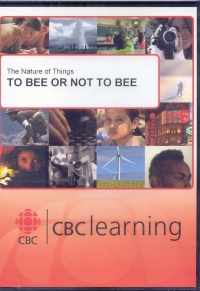| ________________
CM . . . . Volume XVIII Number 31 . . . . April 13, 2012

 |
To Bee or Not to Bee. (The Nature of Things).
Toronto, ON: CBC Learning (www.cbclearning.ca), 2009.
44 min., DVD, $56.25 (Single site license price).
Product ID ZZY-09-17.
Grades 6 and up / Ages 11 and up.
Review by Gillian Richardson.
**** /4
|
| |
|

Because we’re so used to seeing and hearing bees at work in our gardens, we may take it for granted that they’ll always be there. After all, there are about 19,000 species worldwide, living in all kinds of habitats. Recently, though, bee populations have been crashing, sending alarm through the scientific and agricultural communities. Bees are an “irreplaceable pollinator” of one-third of the world’s food crops, as well as wild plants. They have evolved alongside plants, so as the web connecting them to the rest of nature unravels, biodiversity diminishes. What would we do without bees? To Bee or Not to Bee examines the current problems and the ongoing research to find answers.
The film opens with scenes of beekeepers at the distressing task of burning hives that have succumbed to one of several ailments called, ‘Colony Collapse Disorder’. Among the causes being explored are fatigue/stress, inadequate nutrition, effects of pesticides or viruses. Several scientists examining these problems are interviewed, and they discuss various experimental solutions. For instance, the mass transportation of hives to follow the seasonal demand for pollination of huge acreages of agricultural products can fatigue and stress the bees excessively, but this practice has become big business. Furthermore, setting up hives in a monoculture situation means their limited diet may leave the bees nutritionally deficient. Both of these issues have aroused concern among beekeepers who are taking steps to resolve them.
Pesticides may be a more insidious and pervasive problem. Pesticides not only affect the bees through spraying on plants, but also as a systemic poison that has been used, for example, in corn seed and sunflowers in Europe. While the scientists investigate how bees ingest the toxins, protestors march to ban pesticide use.
The issues of disease (several easily transmitted viruses might be present in one hive) and parasites (the Varroa mite has developed resistance to pesticides) have challenged researchers to find non-chemical solutions. For instance, experiments are being conducted to determine if bees can detect infected larvae in their colonies. Since the genome sequence for bees was completed in 2006, it is hoped that breeding strategies might be found to create stronger, more disease resistant bees. It has been found that bees have relatively weak immune systems, a situation which compounds the problems. In one case, in Scotland, a beekeeper is patiently tending his hives in an isolated area, hoping they will build resistance to mites naturally.
To Bee or Not to Bee leaves the viewer to ponder the sobering concepts that stress and a combination of problems, along with changes to natural habitat from modern agricultural practices, may be too much for the world’s bees to overcome.
Top quality video of the bees’ environment and the effects of problems on the population are supported by expert commentary from a number of individuals involved in studying the situation. It is made clear that answers are elusive and the search frustrating. Excellent close-ups of bee behaviour in the hives enhance understanding of the severity of these issues. Powerful images convey the emotional impact of seeing hives decimated, not only because one’s livelihood may be ruined, but due to the long-term commitments and loyalty of beekeepers to a craft they care deeply about, and whose vital nature they well understand.
Teacher Resource Guide:
A 28-page Teacher Resource Guide, Sustainable Ecosystems & Biodiversity Through the lens of Bees, is available to support Grade 9 and 10 science courses in Canada. Its objective is to personalize science, giving students skills and attitudes that will be valuable in any discipline. The guide offers extensive activities and reproducible worksheets to aid in understanding not only the specific details surrounding the environmental problem of disappearing honeybees, but also to extend knowledge about the themes of sustainable ecosystems and biological diversity. The guide focuses on basic concepts, skills of investigation, science, technology, society and environment, and attitudes. The resource guide may also be used with another DVD, Beetalker: The Secret World of Bees, which explores the complexities of beehives. A list of “References and Additional Resources” will allow students to extend their investigations on the topic.
This DVD and guide package will be a valuable tool for teachers to raise awareness of students to the far-reaching effects of threats to ecosystems, as well as to how science relates to them on a daily basis.
Highly Recommended.
Gillian Richardson is a freelance writer living in BC.

To comment
on this title or this review, send mail to cm@umanitoba.ca.
Copyright © the Manitoba Library Association. Reproduction for personal
use is permitted only if this copyright notice is maintained. Any
other reproduction is prohibited without permission.
NEXT REVIEW |
TABLE OF CONTENTS FOR THIS ISSUE
- April 13, 2012.
AUTHORS |
TITLES |
MEDIA REVIEWS |
PROFILES |
BACK ISSUES |
SEARCH |
CMARCHIVE |
HOME |
